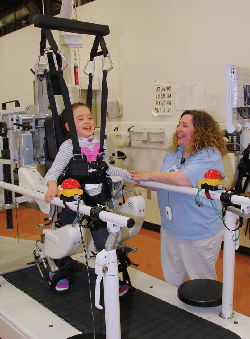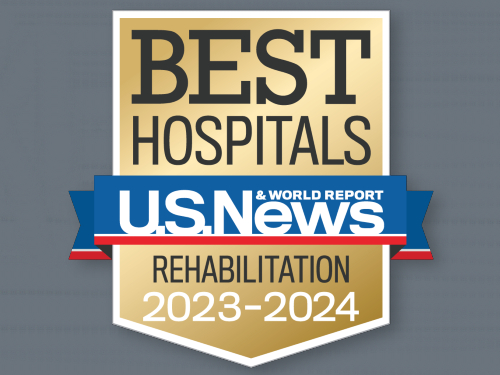
“Natalie was a typical kid living a normal happy life when this happened,” says her mother, Debbie Fraker. “There were no chemotherapy options available, but radiation had been used successfully in other patients. There was some risk of tumor swelling after radiation and risk of injury to the spinal cord, but it was very small – we were told 3%. But everything that could go wrong did, and we ended up in that small percentage.”
Natalie finished radiation therapy in early February 2011, and by April she was suffering complications from the treatment. She and her family spent the next three months in the hospital, facing one setback after another.
“She was left-handed and all of a sudden she had no feeling on her left side and her arm and leg were cold to the touch,” Fraker says. “We did physical therapy in the hospital and watched her lose more ability each week.”
As the tumor shrank in size, Natalie regained some feeling and movement and was discharged to home. “Nothing prepares you for the experience of bringing your child home in a wheelchair,” Fraker says. “But the wheelchair turned out to be the least of our worries. She was still on a ventilator and required 24/7 nursing in the beginning. For a year, our home was a hospital.”
During their daughter’s first year of recovery, the Frakers arranged for in-home therapy. In September 2012, Natalie began speech therapy at TIRR Memorial Hermann Pediatric Outpatient Rehabilitation at the Kirby Glen Center. Over the next several months, she progressed from not being able to swallow to being able to eat. Little by little, she was weaned off the ventilator.
In May 2013, the Frakers added physical therapy and occupational therapy to her rehabilitation plan. “Natalie came to us when she was ready for a more intensive program,” says Teresa Cramer, PT, DPT, PCS.
“By the time she began physical therapy, she could move her arms but had no functional use of them, and she could move her legs but couldn’t stand up. She was unable to hold up her head.”
While Cramer used the Lokomat® to strengthen her legs, trunk and core with the goal of transferring and standing without assistance, occupational therapist Carly Thom, OTR, worked with Natalie on hand strengthening, fine-motor skills and accessing assistive technology.
A mobile arm support attached to her wheelchair gives her right arm a boost, and by working with the assistive technology program at Natalie’s school, Thom arranged access to an iPad. The two of them are working to increase her typing speed.
In addition to learning to interact with technology, Natalie has gained skills that allow her to interact more with people. “One of the biggest benefits of her therapy is the boost in confidence she got from regaining strength,” Thom says. She’s motivated. She’s very smart and knows exactly what she wants and is determined to get there.”
Cognitively Natalie has remained the same through her ordeal. “Many children who undergo radiation to the brain experience changes in their mental processes,” Fraker says. “We’ve dealt with muscular weakness, but she’s been able to keep up with her class in school, even though she’s still going part time. Recently she participated in a school competition called Name That Book. The kids read 30 books, and are challenged to identify a quote from each of the books. We were excited that she was on the team.”
Natalie has also received recognition through the Periwinkle Foundation, which sponsors an arts-in-medicine program. She’s won the best-of-show ribbon for the past two years, and during that period has also been on the A honor roll at her school.
Today, at the age of 8, she’s continuing to work with Cramer on her posture, balance and head control on the Lokomat and in the gym. “Therapy has helped her come out of her shell,” her mother says. “She’s doing a phenomenal job. The things she’s learned in occupational therapy have given her confidence. She’s a different child in her power wheelchair when she has the independence to go where she wants to go. She holds her head higher, literally and figuratively.
“Regaining her skills has been a slow process, but we realize how lucky we are because we did beat the odds,” Fraker says. “We’re still here four years later, and many of the friends Natalie made in the hospital lost the battle. We’re grateful we still have our baby and get to see her enjoying life with her family and friends.”
Contact Us
If you have questions or are looking for more information, please complete the form below and we will contact you.

Nationally Ranked Rehabilitation
For the 35th consecutive year, TIRR Memorial Hermann is recognized as the best rehabilitation hospital in Texas and No. 2 in the nation according to U.S. News and World Report's "Best Rehabilitation Hospitals" in America.
Learn More